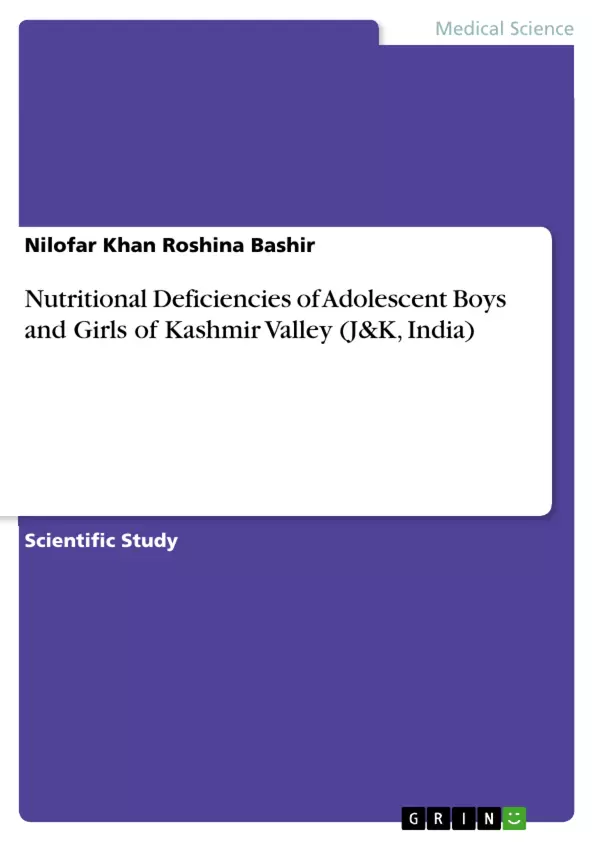The present study focused on nutrition deficiencies of adolescent boys and girls. The field sample for the present study was undertaken in six districts of Kashmir valley J&K (viz, Srinagar, Budgam, Anantnag, Kupwara, Pulwama and Baramulla), covering a sample of 1500 adolescents i.e. 750 boys and equal number of girls in the age group of 10-19 years, study in Government Schools. The findings of the study suggests that lifestyle including nutritional habits track from adolescent into adulthood, thereby lead to increased incidence of chronic disease e.g. cardiovascular diseases, diabetes and cancer. Exposure in childhood and adolescence to adverse life style and faulty food habits such as poor food intake, special meal preferences and patterns and above all sedentary life style may exacerbate this, thus worsening the prognosis. Hence promotion of healthy nutrition habits and physically active life style during adolescent period is a critical public health strategy.
Inhaltsverzeichnis (Table of Contents)
- ABSTRACT
- INTRODUCTION
- MATERIAL AND METHODS
- A. Sample Size
- Sampling Procedure:
- B. Design: - Multi stage sampling procedure.
- C. .Random Tables
- D. Data collection
- E. General Information
- RESULTS
Zielsetzung und Themenschwerpunkte (Objectives and Key Themes)
This study aims to examine the prevalence of nutritional deficiencies among adolescent boys and girls in the Kashmir Valley of Jammu and Kashmir, India. The research focuses on understanding the nutritional status of adolescents and identifying factors that contribute to nutritional deficiencies, highlighting the importance of addressing these issues for public health.
- Nutritional deficiencies among adolescent boys and girls in the Kashmir Valley
- Prevalence of specific nutritional deficiencies, such as anemia, vitamin A deficiency, and scurvy
- The impact of dietary habits and lifestyle factors on nutritional status
- The importance of promoting healthy nutrition and physical activity during adolescence
- The potential long-term health implications of nutritional deficiencies in adolescents
Zusammenfassung der Kapitel (Chapter Summaries)
The study was conducted in government schools in six districts of the Kashmir Valley, involving a sample of 1500 adolescents aged 10-19 years. The research utilized a multi-stage sampling procedure, with data collected through questionnaires and interviews. The results of the study indicate a significant prevalence of nutritional deficiencies among adolescents in the Kashmir Valley.
Schlüsselwörter (Keywords)
The main focus of the study centers around nutrition, deficiency, adolescents, boys, and girls. These key terms encompass the research's primary concerns, including the prevalence and impact of nutritional deficiencies among adolescents in the Kashmir Valley. The research explores the specific nutritional deficiencies observed, the influence of dietary habits and lifestyle factors, and the implications for public health.
- Arbeit zitieren
- Nilofar Khan Roshina Bashir (Autor:in), 2014, Nutritional Deficiencies of Adolescent Boys and Girls of Kashmir Valley (J&K, India), München, GRIN Verlag, https://www.grin.com/document/278341



